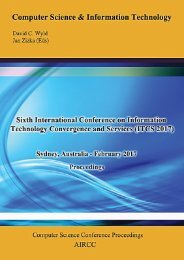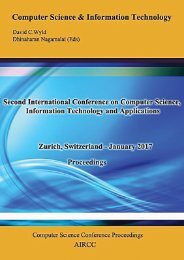CoSIT 2017
Fourth International Conference on Computer Science and Information Technology ( CoSIT 2017 ), Geneva, Switzerland - March 2017
Fourth International Conference on Computer Science and Information Technology ( CoSIT 2017 ), Geneva, Switzerland - March 2017
You also want an ePaper? Increase the reach of your titles
YUMPU automatically turns print PDFs into web optimized ePapers that Google loves.
NEW NON-COPRIME CONJUGATE-PAIR<br />
BINARY TO RNS MULTI-MODULI FOR<br />
RESIDUE NUMBER SYSTEM<br />
ABSTRACT<br />
Mansour Bader 1 , Andraws Swidan 2 , Mazin Al-hadidi 1<br />
1 Department of Computer Engineering,<br />
Al-Balqa'a Applied University, Salt, Jordan.<br />
2 Department of Computer Engineering,<br />
Jordan University, Amman, Jordan.<br />
In this paper a new Binary-to-RNS converters for multi-moduli RNS based on conjugate-pair as<br />
of the set { 2 n1 – 2, 2 n1 + 2, 2 n2 – 2, 2 n2 + 2, …, 2 nN – 2, 2 nN + 2 } are presented. 2 n – 2<br />
and 2 n + 2 modulies are called conjugates of each other. Benefits of Multi-moduli RNS<br />
processors are; relying on the sets with pairs of conjugate moduli : 1) Large dynamic ranges. 2)<br />
Fast and balanced RNS arithmetic. 3) Simple and efficient RNS processing hardware. 4)<br />
Efficient weighted-to-RNS and RNS-to-Weighted converters. [1] The dynamic range (M)<br />
achieved by the set above is defined by the least common multiple (LCM) of the moduli. This<br />
new non-coprime conjugate-pair is unique and the only one of its shape as to be shown.<br />
KEYWORDS<br />
Binary , Conjugate-Pair , Dynamic range, LCM, Multi-moduli.<br />
1. INTRODUCTION<br />
RNS is known to support parallel, carry-free, high-speed arithmetic , because it is considered as<br />
an integer system, that is appropriate for implementing fast digital signal processors [1] . It is also<br />
has main importance in Encryption and Cryptography fields. Other applications include – but not<br />
limited to - Digital Signal Processing, correlation, error detection and correction [1 - 3].<br />
RNS basis form is a set of relatively prime integers P = { m1, ….., mk } where gcd (mi, mj ) = 1<br />
for i ≠ j. In this paper we are showing that the new non-coprime moduli set presented in [2] could<br />
be used in the new non-coprime multi-moduli conjugate-pair Weighted-to-RNS converters.<br />
The set P for prime case is the moduli set with the dynamic range (M) of the system M = π mi.<br />
But for our case and since each conjugate has the number 2 as a common factor other than the<br />
number 1 as in the prime one, the M = ∏<br />
mi / 2^(k − 1)<br />
.<br />
For both cases coprime and non-coprime; any integer xͼ [0, M – 1] has an RNS representation X<br />
= (x1 , … , xk), where xi = X mod mi .<br />
Dhinaharan Nagamalai et al. (Eds) : <strong>CoSIT</strong>, SIGL, AIAPP, CYBI, CRIS, SEC, DMA - <strong>2017</strong><br />
pp. 105– 111, <strong>2017</strong>. © CS & IT-CSCP <strong>2017</strong><br />
DOI : 10.5121/csit.<strong>2017</strong>.70411





